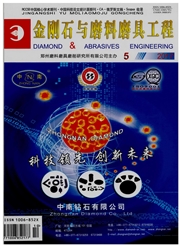

 中文摘要:
中文摘要:
通过 SEM 、EDS 及 XPS 研究了银铜钛合金真空钎焊含硼金刚石界面结合处微结构,运用热力学及动力学理论分析界面原子扩散机制、反应生成物结构及生长过程,并在不同条件下测试磨粒静压强度和冲击强度。实验结果表明:高温钎焊过程中,C 原子处于扩散前沿,与偏聚的 Ti 原子优先生成 TiC ;随着反应时间的延长,B 原子经化合反应生成 TiB2。 TiC 与 TiB2的热膨胀系数非常相近,约7.4×10-6/ K ,因此生成物之间的热应力极小,且形成了类似 TiB2‐TiC 复合材料结构,实现了磨粒与钎料之间牢固的冶金结合。钎焊后含硼金刚石静压强度与冲击强度分别提高5.4%和34.8%,同时良好的自锐性使钎焊含硼金刚石工具在难加工材料方面有着良好的应用前景。
 英文摘要:
英文摘要:
The interfacial microstructure of boron‐doped diamond brazed with Ag‐Cu‐Ti alloy , was studied by means of SEM , EDS , XPS . Theory of thermodynamic was applied to analyze the microstructure diffusion mechanism , the structure and grow th process of reaction product . Additionally , the static and impact strength of grain was tested under different conditions . The results showed that in the process of vacuum brazing , TiC was preferentially generated in front of the diffusion . As time went on , TiB2 was formed through combination reaction . Due to the similar thermal expansion coefficients between TiC and TiB2 , composite structure of TiB2‐TiC would be formed and the thermal stress reduced , which resulted in the metallurgical bonding between the grains and the filler . After brazing , the static and impact strength of boron‐doped diamond increased by 5 .4% and 34 .8% , respectively . In addition , with the good self‐sharpening ability , the brazed boron‐doped diamond tool would have a predictable application in difficult‐to‐cut materials .
 同期刊论文项目
同期刊论文项目
 同项目期刊论文
同项目期刊论文
 期刊信息
期刊信息
